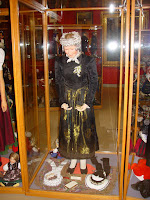
One of the things I like to include on our Heritage trips is a visit to a local history museum, or a Heimatmuseum, as they are called in Germany. Here you get to see articles of the past that were used in that town or region and help you to picture what your ancestors life was like, sometimes these include traditional dress too. I would like to talk a little about folk dressing in Germany and include some pictures from some of these museums we have been to.
The traditional or folk costumes of the Germans have been studied extensively. Regional or folk costume did not exist in the Middle Ages. Workers on small bits of land were subjects of a landlord or some sort of overlord. There was little time for weaving and construction of even the simplest garments. Dress of the working people was usually made at home of home grown linen or wool from their flocks and was sturdy enough to last a lifetime.
Throughout Europe during this time men wore a simple tunic and short breeches held up by a strip of leather or other material threaded through the top of the garment. Early Germans wore long straight trews or trouser with notched (dagged) edges to prevent them from fraying. Sometimes strips of fabric bound the trousers to the legs,calf or ankles. For winter a short cloak was added.
Women's dress was made from two straight pieces of fabric sewn without shoulder or waistline seams. A girdle held in this long, simple gown at the waistline. The lower portion of the gown was often drawn up or looped over the girdle to facilitate working in the fields or household. Extra warmth was provided by a simple cloak draped over the head and pulled around the body. Hats woven of straw were worn by both men and women during the summer to protect them from the sun.
Costume of the upper classes and wealthy tradesmen tended to be of a more elaborate international style. The middle classes in the towns developed a dress of a distinct form from that of royalty and the nobility and from that worn by the working men and women.
Traditional regional folk costumes are not very old. They start to develop from the fashions of the late middle ages. There seemed to be little regional dress in the fifteenth & sixteenth centuries. Probably this was a result of constant wars and invasions. Materials, however, were regional with more woolen garments in some countries coarse linen in others. Colors varied according to the plants which were grown locally for dyes.
In the 17th century the first signs of regional dress appeared as well as differences in clothing of the wealthy
 farmer and the poorer laborers. Elaborateness of dress in the different regions depended in part upon the prosperity of the region. Rural populations usually were clad in clothes which were made in their own area. The small town tailor usually did not keep pace with more rapid changes affecting the towns. Albert Reinhardt in his book, TRADITIONAL COSTUMES IN THE BLACK FOREST, p.16, observed that it probably "against the grain of countrymen that something is loved today and abandoned tomorrow." As the modern European nations came into existence, a regional dress also preserved the identification rural folk have with a particular spot of land. Once a primary form was established, certain elements of the current fashion were often incorporated into the style of a particular region.
farmer and the poorer laborers. Elaborateness of dress in the different regions depended in part upon the prosperity of the region. Rural populations usually were clad in clothes which were made in their own area. The small town tailor usually did not keep pace with more rapid changes affecting the towns. Albert Reinhardt in his book, TRADITIONAL COSTUMES IN THE BLACK FOREST, p.16, observed that it probably "against the grain of countrymen that something is loved today and abandoned tomorrow." As the modern European nations came into existence, a regional dress also preserved the identification rural folk have with a particular spot of land. Once a primary form was established, certain elements of the current fashion were often incorporated into the style of a particular region.These regional costumes hardly survive at the present time in Western Europe unless they are
 used as an attraction for tourists or preserved to wear during local festivals. Many individuals traveling to the area where their family originated may be able to find pieces of these regional costumes. In some places you can find a tailor or seamstress who will make one for you. These are worn with pride for special occasions in the U.S.A.
used as an attraction for tourists or preserved to wear during local festivals. Many individuals traveling to the area where their family originated may be able to find pieces of these regional costumes. In some places you can find a tailor or seamstress who will make one for you. These are worn with pride for special occasions in the U.S.A.Red Pom-Poms on a straw hat in the Black Forest means Unmarried woman. Black pom-Poms designate married women.


 Other dresses for special occasions in the Black Forest.
Other dresses for special occasions in the Black Forest.These dresses are from the Northwest of Germany, a museum in the town of Rahden.


A Farmer's wife outfit and a Sunday outfit and baby's christening Dress


Linen undergarments from the Northwest Germany and a farm wife's collection of "linens" The Northwest of Germany, Westphalia and Niedersachsen were big linen weaving areas.
These museums are a wonderful way to "picture" what your ancestor looked like.

No comments:
Post a Comment